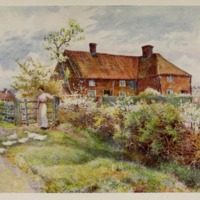Description
The Manor House in Austerfield is popularly thought to be the place where William Bradford, orphaned as a child, was brought up by his paternal grandfather and uncles. Bradford became associated with the Brownists during his adolescence before relocating to Holland and eventually sailing on the Mayflower to America in 1620. Described by Marcus Huish in 1907 as ‘a typical yeoman’s dwelling’, Elizabeth Chettle provides a watercolour of the red brick manor house in the small village. As Huish describes:
"Austerfield consists of nothing more than a village street of unpretentious cottages with a tiny church of ancient date, having a good porch of Norman work. From the archives kept in an old muniment chest in the building the following particulars have been gleaned as to the family of this youth, who was William Bradford, first Governor of Plymouth, New England, and the first historian of the colony.
[…]
Bradford's house at Austerfield is still in existence, and is a typical yeoman's dwelling. It is termed the Manor House. The church services are said to have been held in the cellar, a small damp room, twelve feet square, and only lit by one window some fifteen inches wide."

